THE HUNGRY BURGLARS OF HENRY ST. (1890)
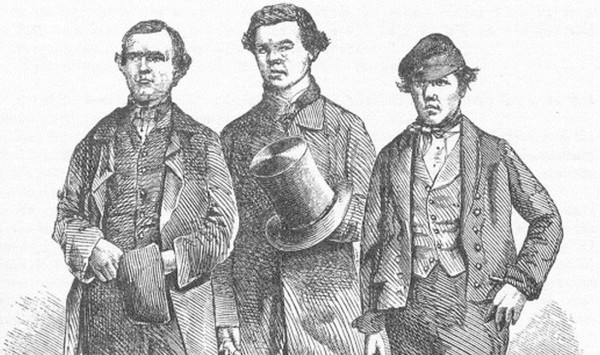
******************************************************************************************************************************** Brownstone Detectives investigates the history of our clients’ homes. The story you are about to read was composed from research conducted in the course of one of those investigations. Do you know the history of YOUR house? ******************************************************************************************************************************** Not all burglars are intent on “getting in and out quick.” And so it was when, in 1890, two Brooklyn thieves, during a burglary of a Brooklyn Heights home, actually interrupted their own burgling in order to sit down and enjoy a full meal – before carting off their substantial haul. It was in the wee hours of a February morning when the men were prowling about for a target of opportunity. Approaching Henry Street, they noticed the corner house at No. 303. The entire house was dark and so, hopping the fence, they approached the back of the residence to check the kitchen windows. Finding them closed and locked, they forced one of them open, then entered the house. The Brooklyn Daily Eagle noted that the burglars, at this point, began to help themselves to “everything they could find on the basement floor.” In the process they “broke open the cook’s trunk and stole $18 of her savings,” and “carried away silverware and a clock valued at $60.” Before going, however, finding themselves hungry and realizing they were in the house’s kitchen, they located the dishware and glasses, and fastidiously set the table. Soon, they were all seated and enjoying “a substantial meal of meat, bread, cake, and other articles […]
THE DAY BED-STUY WAS BORN (1895)
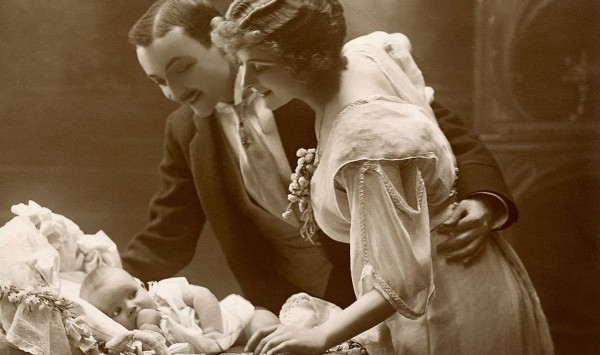
******************************************************************************************************************************** Brownstone Detectives investigates the history of our clients’ homes. The story you are about to read was composed from research conducted in the course of one of those investigations. Do you know the history of YOUR house? ******************************************************************************************************************************** Bedford-Stuyvesant, known coloquially as “Bed-Stuy,” is a section of Brooklyn that conjures as many mental images as there are residents of the district. With a past as colorful and storied as any other section of the borough, its ups and downs, though, seem to have been much more extreme. One only need consider the district’s unofficial slogan for much of the past 30 years, “Bed-Stuy: Do or Die,” to dredge up a very recent period sadly associated with images of guns, drugs, and gang violence. But this more recent history is not the point of this story. We want to go further back to try and understand how Bedford, which was formerly a village built up around the intersection of Bedford Avenue and what would become Fulton Street, joined with the developing neighborhood of Stuyvesant Heights. The official birthdate of Bedford-Stuyvesant has always been a moving target depending on the reference made or its actual source. Any discussion of its original designation would need to consider the fact that the term “Bedford-Stuyvesant” came about colloquially, and so unofficially, at first, but later took on the mantel of authority. WAS BED-STUY BORN IN THE ’30S? The majority of designations have placed Bed-Stuy’s birthday squarely within the 1930s. The New York Times, in […]
THE “WET SPECIMEN” OF HALSEY STREET (1899)
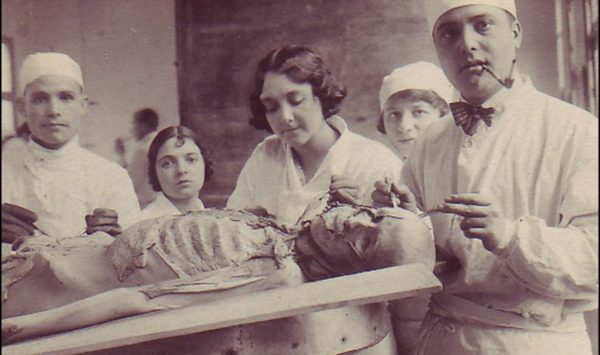
******************************************************************************************************************************** Brownstone Detectives investigates the history of our clients’ homes. The story you are about to read was composed from research conducted in the course of one of those investigations. Do you know the history of YOUR house? ******************************************************************************************************************************** When a body was discovered in the cellar of a brownstone on Brooklyn’s Halsey Street, the police were immediately notified and the “owner” hunted down… The medical profession, like most other professions, was much less regulated in the 19th century than it is today. Those who worked within the medical studies of the period – involving the dissection of corpses, the experimentation on recently live human organs, or the display of exoskeletal remains – were just as similarly unregulated. There was a medical practice, however, which was associated with the medical profession but which also appeared more morbid – it provided for education of medical students through the preservation (and display) of certain organs, animals, or tissue specimens. This practice appears to have fallen, however, into an altogether different grouping of practices – at least as regarded the general public. This was the practice – long important to the preservation of biological specimens for observation and continued study – of the preservation of biological tissue within alcohol-filled jars – otherwise known as “wet specimens.” While these specimens were a common site within a laboratory, hospital, or teaching school, such specimens were rarely known to disappear from these locations and, more rarely so, to find themselves upon the cellar shelves of a […]
SATAN’S CANDY SHOP (1911)
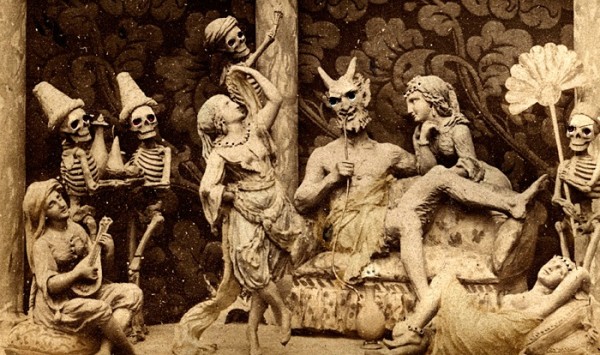
******************************************************************************************************************************** Brownstone Detectives investigates the history of our clients’ homes. The story you are about to read was composed from research conducted in the course of one of those investigations. Do you know the history of YOUR house? ******************************************************************************************************************************** If a man named Hell offered you some candy – would you take it? That was Otto Herman Hell’s problem. And, yes, in fact he was about to open a confectionery in Brooklyn on Broadway. THE DEVIL’S CONFECTIONER It must have been difficult growing up with a name like Hell. There were probably countless jokes and plays on the name. Otto must have been quite tired of it all by the time he reached the age of maturity, at which point he began thinking seriously about changing it. Having emigrated from Germany in 1891, he was 25 when the immigration officials must have looked up at him in surprise as he stood before them hoping to gain entry into the country. “Hell? Hell?” the official must have half-asked, half-shouted, incredulously. “O’Connor, come quick, or you’ll have Hell to pay!” Lots of uproarious laughter here, then a loud stamp, and then Hell was on to the next set of jokes somewhere in his new country. He probably found it curious in the early days, perhaps a bit enjoyable if he had had a playful streak. But, by George, it was 1911 now, and Otto was 36 with a wife and two children. He was more than ready to get serious with his […]
SHAKESPEARE AT NO. 24 BREVOORT PL (1928)
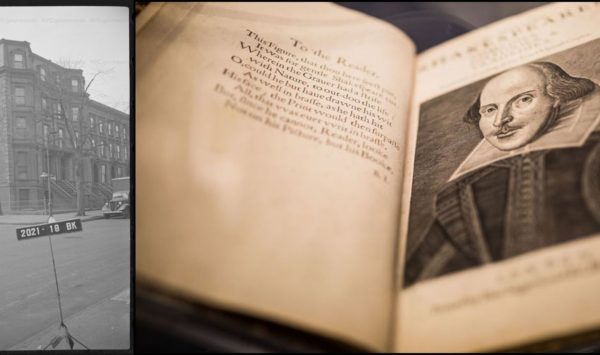
******************************************************************************************************************************** Brownstone Detectives investigates the history of its clients’ homes. The story you are about to read was composed from research conducted in the course of one of those investigations. ******************************************************************************************************************************** Henry C. Folger loved Shakespeare. His admiration for the author and his writings was such that he once paid $100K for a single folio of the bard’s work. The president of the Standard Oil Company was so smitten with Shakespeare’s works that, in 2014, a book, Collecting Shakespeare, was published about Folger and his collection. Folger, who started his relationship with Standard Oil as its director, would rise to become the chairman of its board, building a trusted relationship with the company’s owner, John D. Rockefeller, Sr. While frugal in the management of his money, Folger’s position with the largest oil company in the world certainly allowed him plenty of it to use in the pursuit of everything Shakespeare. And everything Shakespeare that he purchased for his collection eventually made its way to the library of their rented house at No. 24 Brevoort Place in Brooklyn, where the couple would live from 1910 through the early 1930s. FOLGER, BREVOORT, & SHAKESPEARE Henry Clay Folger’s collection of Shakespeareana included 35 copies of the 1623 first folio edition, of which only 200 copies were then known to be in existence. These earliest texts of William Shakespeare’s works were published during the 16th and 17th centuries in quarto or folio format. While quartos are smaller volumes, folios are large, tall volumes, roughly […]
THE BOY HOODLUMS OF HANCOCK STREET (1899)
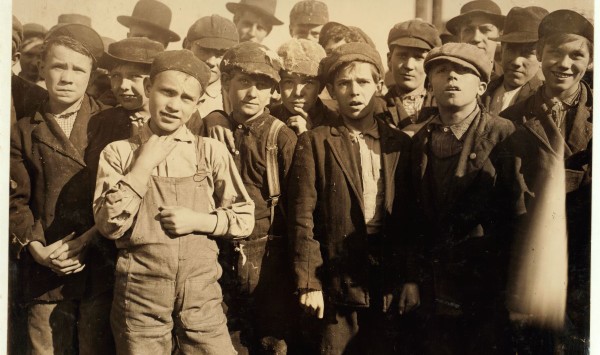
******************************************************************************************************************************** Brownstone Detectives investigates the history of our clients’ homes. The story you are about to read was composed from research conducted in the course of one of those investigations. Do you know the history of YOUR house? ******************************************************************************************************************************** If you were a boy hoodlum in “Bed-Stuy” back in 1899, then it is a good bet that you conducted your “outrages” along that stretch of Howard Avenue between Halsey and Hancock Streets. For it was there that a “small reign of terror” was “inaugurated” during this period, as small gangs of boys “armed with sticks and stones” prowled about the area with determined mal intent. A NEIGHBORHOOD COMPLAINS – THE EAGLE RAILS “The irrepressible and unregenerate young generation of boys in the vicinity of Howard avenue and Halsey street are making existence a heavy load to the law abiding population of that community,” railed the Brooklyn Daily Eagle. “The choicest lot of hoodlums in the city have banded themselves together,” the paper continued “and use that block as a fixed center, from which they conduct a campaign of well planned outrages for a radius of many blocks around.” A CASE IN POINT Two boys, in particular, were reported to the police after having assaulted a “little 10 year old boy who was going to the grocery store for his mother.” The boys, a 14-year-old member of the Earle family living at at 73 Howard Avenue and a boy named Goldstein, living at 96 Howard Avenue, “led the charge upon the […]
BOYS DROWNING AT CONEY ISLAND (1889)
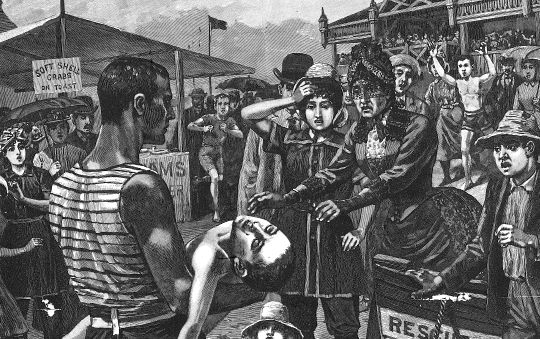
******************************************************************************************************************************** Brownstone Detectives investigates the history of our clients’ homes. The story you are about to read was composed from research conducted in the course of one of those investigations. ******************************************************************************************************************************** Lifesaving at Coney Island has existed since sunbathers have been flocking there to lie along the beach and swim in the surf. As such, there were constantly brave or foolish little boys who thought that they could swim further and further into the briny blue. Many such instances ended in drownings – or near drownings if the lifeguards got to you in time. Two such incidents occurred on one day in 1897. One, “Nathan Nichols, a Negro Boy,” had “drowned in the surf.” Nicholls, 18 years old, who was employed by a feed man on Neptune Avenue, whose custom it was every Sunday to give his employer’s horses a bath in the surf. About noon, Nicholls was riding one of the hoses in about seven feet of water, off the foot of Ocean Parkway when we was suddenly seen to slide from the animals’ back and disappear. When Nicholls did not reappear, a few people on shore who had been watching ran to the police station. A roundsman grappled for the body for an house but failed to locate it. The body had not been recovered. Worse must have been a drowning in the Gowanus Canal where, it might be expected, a boy would be able to grapple his way to shore before sinking into the murky depths. One […]
NAKED BOY, CITY FOUNTAIN (1898)

******************************************************************************************************************************** Brownstone Detectives investigates the history of our clients’ homes. The story you are about to read was composed from research conducted in the course of one of those investigations. Do you know the history of YOUR house? ******************************************************************************************************************************** It was a scene perhaps repeated multiple times in a year by countless naked little boys. In June of 1898, however, one little “naked fugitive” was accosted by a “fat policeman” in the fountain of New York’s City Hall Park. Here is how he got away. BATHED NUDE IN CITY HALL PARK “An altogether naked boy of perhaps 12 years and a fat policeman with clothes to spare furnished joy for the people in City Hall Park last evening, at about half-past 6 o’clock,” began an article in The Sun. “The boy had been splashing around in the pool around the fountain. The park loafers were roused to comment with some animation upon the young man’s bravery and lack of modesty.” Apparently, in a time when such boyhood antics were looked down upon with quaint – even for the time – disapproval, for some reason, passersby “could’t avoid smiling tolerantly as they looked the other way.” ENTER THE POLICEMAN “The big policeman who came puffing from Park row took no such amiable view of the young man’s crime. For years,” The Sun continued, “small boys have been given to jumping into the fountain with all their clothes on.” A naked boy, however, as the paper implied, was rare. “A hundred voices […]
HORSEWHIPS, HARLEYS & HEROES ON CLASSON
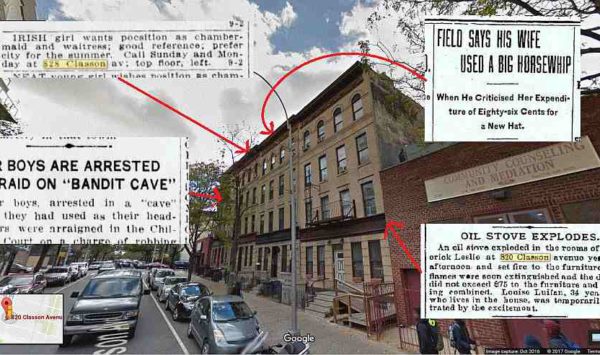
******************************************************************************************************************************** Brownstone Detectives investigates the history of our clients’ homes. The story you are about to read was composed from research conducted in the course of one of those investigations. Do you know the history of YOUR house? ******************************************************************************************************************************** “Every house has a story to tell.” That is how the Brownstone Detectives visualizes every structure, building, and house – as historical repositories for their human narratives. And the Brownstone Detectives, a for-hire historical research team, has investigated many of the stories that are a part of these narratives. And Brownstone Detectives has literally seen them all – from accounts concerning a house’s residents (unrequited love, murder, discrimination, &c.) to those involving the buildings themselves (explosions, fires, hidden rooms, &c.). “If you’re sitting in an old house right now – anywhere in this country – the human drama that’s taken place all around you would surprise the heck out of you,” said lead detective Brian Hartig. …NOW TO THOSE HORSEWHIPS… To give an example of the veritable goldmine of stories linked to every Brooklyn house, the detectives recently scratched the surface on a row of four connected tenement buildings in the Prospect Heights section of Brooklyn. The brick and brownstone tenement buildings at Nos. 820-832 Classon Avenue display a cross-section of the colorful tales that newspapers used to cover in their beats. In fact, due to the transient nature of the residents of these specific buildings over the 120 years of their existence, these structures hold an even larger number of the […]
THE DAY RIOTERS STORMED BROOKLYN (1895)
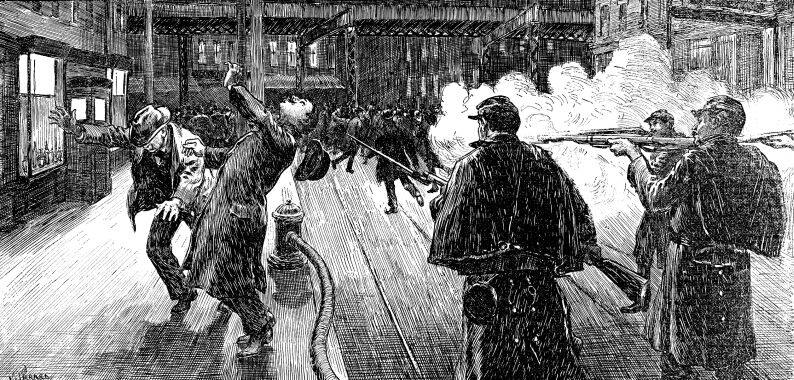
******************************************************************************************************************************** Brownstone Detectives investigates the history of our clients’ homes. The story you are about to read was composed from research conducted in the course of one of those investigations. Do you know the history of YOUR house? ******************************************************************************************************************************** (The above picture shows the New York State militia shooting a man on Halsey Street, near the corner of Broadway. You can see the recently erected elevated train line at the end of the block.) In 1895, Halsey Street near Saratoga Park had become a war zone. The Brooklyn Streetcar strike had begun on 15 January, and before the week was over the agitation would be in full force. The strike, which began with a walkout, would quickly devolve into a pitched battle between the Knights of Labor and streetcar workers on one side and the streetcar line owners, the police and the New York State Militia on the other. The main focus of much of the strikers’ attention in this part of Brooklyn, though, was the Halsey Street Rail Road Barns. These, located near the corner of Halsey Street and Broadway, were where the streetcar line stored its cars, quartered its horses, and from whence the line’s streetcars were dispatched. After the workers had called the strike, 5,500 of them would walk off the job for better conditions. The streetcar line owners (the lines were privately owned and operated at the time) countered this strike by calling in scabs who would attempt to operate the streetcars in the workers’ absence. […]